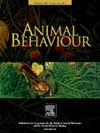警报提示特性和安乐死对临时蛙和蟾蜍蝌蚪反捕食者行为的影响
IF 2.1
2区 生物学
Q2 BEHAVIORAL SCIENCES
引用次数: 0
摘要
化学线索对水生生物评估捕食风险至关重要,影响它们的反捕食机制。蝌蚪,被认为是有价值的模式生物,使用相同的警报提示来调节它们的行为。然而,化学通讯研究中的伦理考虑往往需要使用化学麻醉剂,这可能会破坏生态相关过程并使结果解释复杂化。此外,我们对大多数无尾猿物种的警报信号特征及其与化学麻醉剂的潜在相互作用的理解仍然有限或未被探索。在这项研究中,我们研究了安乐死和提取处理技术对蟾蜍(Bufo Bufo)和青蛙(Rana temporaria)蝌蚪行为的影响,以达到三个目标:研究警报提示特性,评估安乐死方法对警报提示有效性的影响,以及探索使用三卡因和l-精氨酸的麻醉干扰机制。蝌蚪暴露在各种化学刺激下,包括通过机械、低温和化学安乐死方法提取的警报信号,以及不同加工的粗提取物(以前是冷冻、煮沸、陈化或蛋白质消化)。此外,蝌蚪暴露于不同浓度的l-精氨酸和三卡因,无论是单独的还是联合的。我们的研究结果显示了一致的物种特异性反应,短叶蛙蝌蚪对警报提示的反应表现出活动减少,而蟾蜍蝌蚪没有表现出行为变化。此外,我们观察到不同安乐死方式的显著差异。蝌蚪对加工提取物和l-精氨酸有反应,表明在警报提示中存在氨基酸而不是蛋白质化合物。最后,不同物种对l-精氨酸和三卡因的反应表明个体内部的干扰,而不是警报信号。这项研究增强了我们对蝌蚪报警线索特征的理解,并强调了化学麻醉剂对水生生物行为反应的潜在物种特异性影响。强调了进一步研究干扰机制和替代安乐死方法的必要性,同时强调了比较研究对理解水生生态系统中化学通讯的重要性。本文章由计算机程序翻译,如有差异,请以英文原文为准。
Alarm cue properties and euthanasia impact on tadpole antipredator behaviour in Rana temporaria and Bufo bufo
Chemical cues are crucial for aquatic organisms to assess predation risks, impacting their antipredator mechanisms. Tadpoles, recognized as valuable model organisms, use conspecific alarm cues to modulate their behaviours. However, ethical considerations in chemical communication research often necessitate the use of chemical anaesthetics, potentially disrupting ecologically relevant processes and complicating result interpretation. Furthermore, our understanding of alarm cue characteristics across most anuran species and their potential interactions with chemical anaesthetics remains limited or unexplored. In this study, we examined euthanasia and extract processing techniques on tadpole behaviour in the common toad, Bufo bufo, and common frog, Rana temporaria, to achieve three objectives: investigate alarm cue properties, assess the impact of euthanasia methods on alarm cue effectiveness, and explore anaesthetic interference mechanisms using tricaine and l-arginine. Tadpoles were exposed to various chemical stimuli, including alarm cues extracted via mechanical, hypothermal and chemical euthanasia methods, as well as differently processed crude extracts (formerly frozen, boiled, aged or protein-digested). Additionally, tadpoles were exposed to varying concentrations of l-arginine and tricaine, both individually and in combination. Our results revealed consistent species-specific responses, with R. temporaria tadpoles exhibiting reduced activity in response to alarm cues, while B. bufo tadpoles displayed no behavioural changes. Moreover, we observed significant differences among methods of euthanasia. Tadpoles of R. temporaria responded to processed extracts and l-arginine, indicating the presence of amino acids but not proteinaceous compounds in alarm cues. Finally, divergent species’ responses to l-arginine and tricaine suggest interference within individuals rather than alarm cues. This study enhances our understanding of alarm cue characteristics in tadpoles and underscores the potential species-specific impact of chemical anaesthetics on behavioural responses in aquatic organisms. It underscores the necessity for further research into interference mechanisms and alternative euthanasia methods while emphasizing the importance of comparative studies in comprehending chemical communication in aquatic ecosystems.
求助全文
通过发布文献求助,成功后即可免费获取论文全文。
去求助
来源期刊

Animal Behaviour
生物-动物学
CiteScore
4.60
自引率
8.00%
发文量
236
审稿时长
10.2 weeks
期刊介绍:
Growing interest in behavioural biology and the international reputation of Animal Behaviour prompted an expansion to monthly publication in 1989. Animal Behaviour continues to be the journal of choice for biologists, ethologists, psychologists, physiologists, and veterinarians with an interest in the subject.
 求助内容:
求助内容: 应助结果提醒方式:
应助结果提醒方式:


